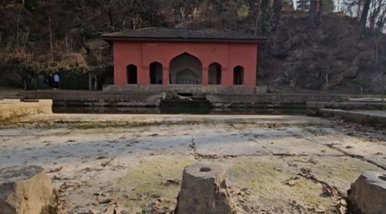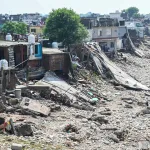The climate change, anthropogenic pressures and making these gifted ecosystems as dumping yards are the major causes of drying up of these springs
The famous Achabal Spring dried up for the first time in history; almost 10 villages depend on drinking water and irrigation facilities from the waters of this spring. This spring was not only a tourist attraction but also a backbone for main water source to irrigate the rice fields, orchards of various villages and was catering the day to day needs of about one lakh people of south Kashmir. The drying up this spring has created the problem of water scarcity in the area.
The climate change, anthropogenic pressures and making these gifted ecosystems as dumping yards are the major causes of drying up of these springs. In a recently published report by government of India there are four main reasons for drying up of springs in Indian Himalayan region which include reduction in precipitation, change in land cover and land use (e.g., reduction in forest cover and natural farming), landslide/land subsidence and erratic weather conditions. All these four factors are prevalent in Kashmir Himalaya.
The Himalayan mountain systems retain rain and snow water by some rocky systems that have porosity and permeability to hold this water. This groundwater erupts in the form of springs.The area from which the water seeps into the ground and emerges elsewhere through springs is called a natural recharge area. Several such areas in Jammu and Kashmir, Ladakh, Himachal Pradesh, Uttarakhand and northeastern states have been affected by the causes that lead to drying up of springs.
The impact of climate change like reduction in precipitation has been witnessed during 2024 and also during the current year. Director of Indian Meteorological Department (IMD) for Jammu and Kashmir told in a recent interview that Kashmir recorded a minus 76.87 percent dip in precipitation between 1st to 6th January. The deficit in snow and rainfall results in reduction in groundwater and ultimately drying up of the prized water resources.
The unplanned developmental works like constructional activities in higher mountains, massive urbanization, dredging of river beds in the south Kashmir is impacting the fragile geology of the area, also affecting subsurface arrangement of rocks, through which springs are both recharged and flow. The other factors include deforestation in the area during last few decades which also resulted in landslides and land subsidence also added in the disappearing of the water resources.
In a recently published report some three million springs flow across the Indian Himalayan region and about half of these have either dried up or are in various stages of disappearing. If we continue with the current practice God forbid we may lose some more important springs in the Kashmir valley. It is high time that all the political parties, NGOs, religious groups and academicians take part in educating the people not to pollute the water bodies and conserve them for future.
In the changing global climate change scenario and the present prevalent mindset of economic–social–environmental relations, the government needs to change the mindset and frame policies towards conservation of nature and natural resources. The government should allocate appropriate budget and devise policies in Kashmir Himalaya for sustainable development of these natural gifts.
Preventing spring depletion requires sustainable land management. It is not enough to simply protect areas close to springs with fences and trees. We also need to identify areas where groundwater enters the soil and is contained between layers of rocks. Such areas can be located in other villages or catchments. Therefore, close collaboration between spring communities and stakeholders in recharge areas is essential.
Proper guidelines should be framed before starting the infrastructure development, laws should be enforced to prevent excessive urbanization, deforestation, and proper knowledge should be disseminated amongst all the walks of life regarding importance of nature and natural resources for sustainable development and existence of life.
(Author is Asst professor, Dept of Botany, University of Kashmir North Campus. Feedback: [email protected])







